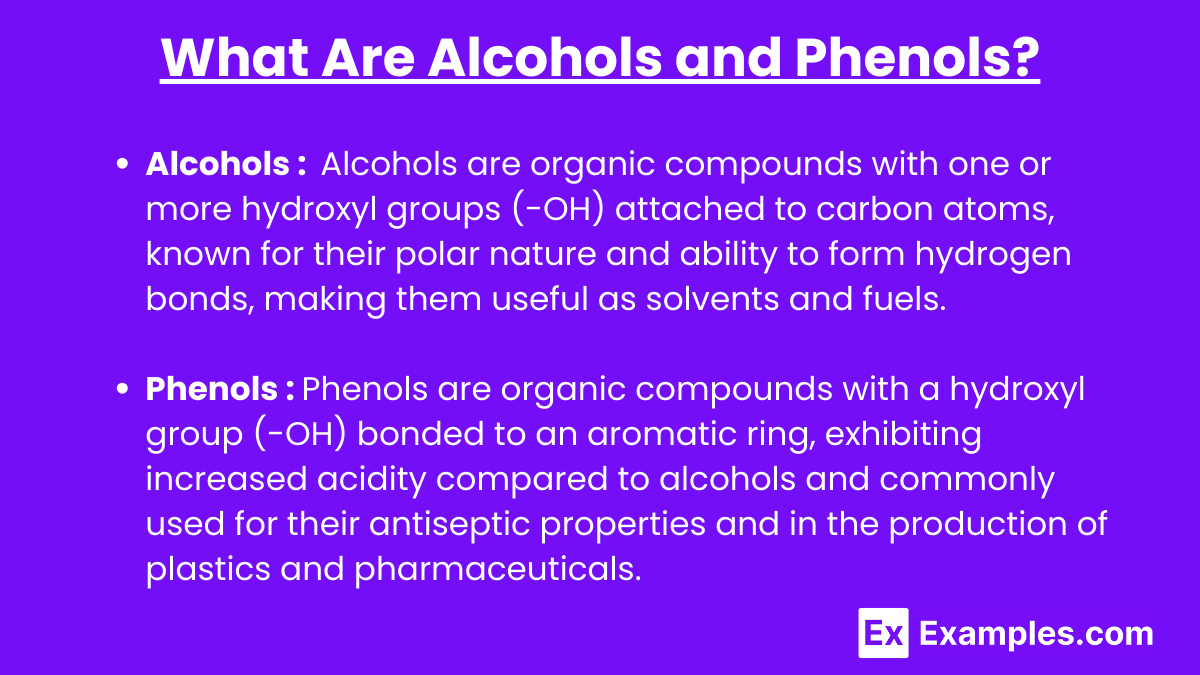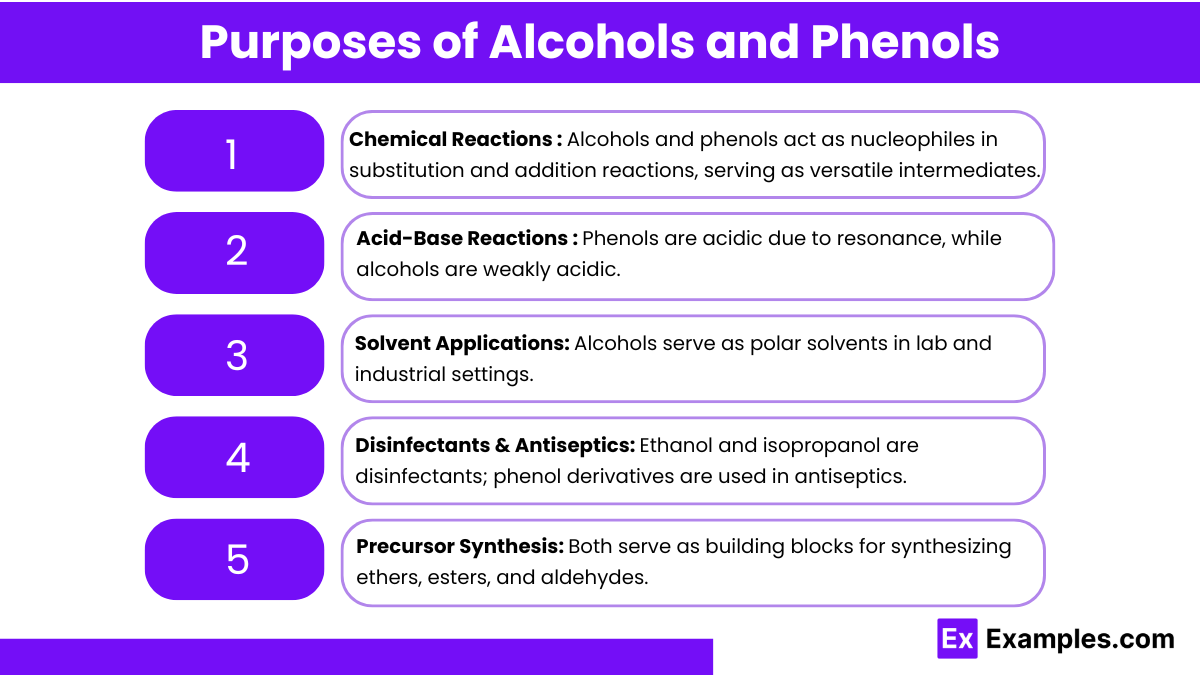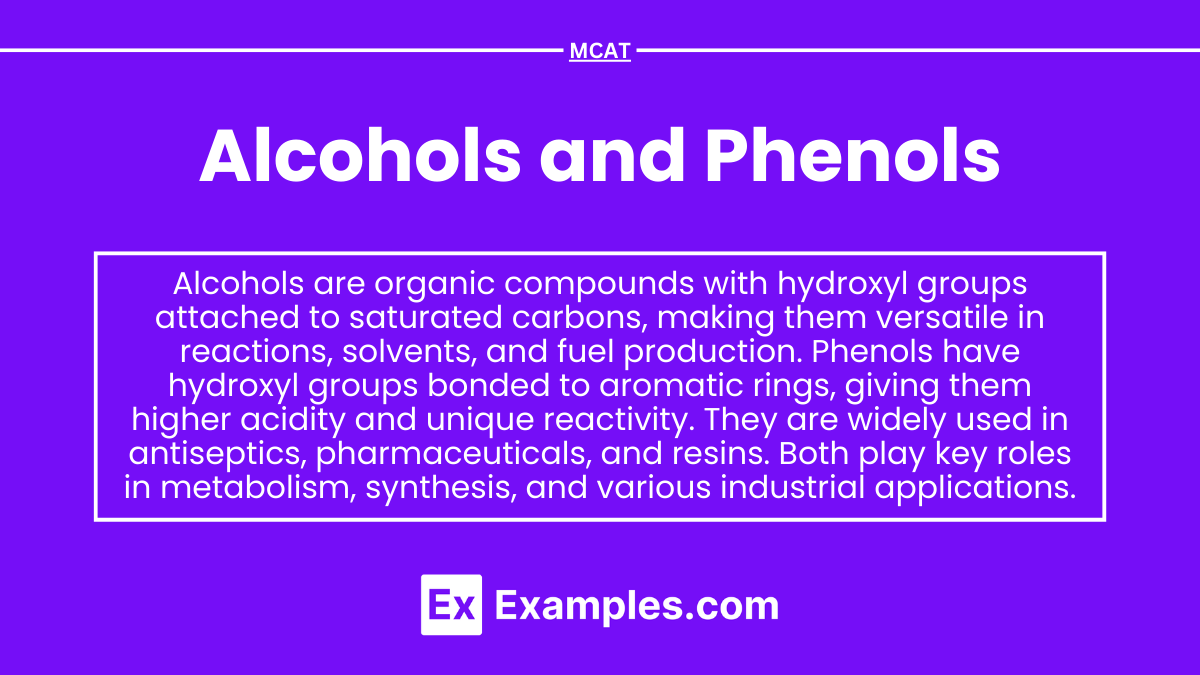Alcohols and Phenols

- Notes
Alcohols and phenols are two significant classes of organic compounds. Alcohols contain a hydroxyl (-OH) group attached to an aliphatic carbon, while phenols have a hydroxyl group linked to an aromatic ring. These compounds play essential roles in various biological, industrial, and synthetic processes. Understanding their reactivity and properties is fundamental for mastering organic chemistry concepts on the MCAT, particularly in topics related to chemical reactions, synthesis, and functional group behavior.
Learning Objectives
When studying “Alcohols and Phenols” for the MCAT, focus on their structure, physical properties, and acidity. Study reactions such as oxidation, esterification, and nucleophilic substitution involving these compounds. Pay attention to synthesis methods, reaction mechanisms, and their roles as intermediates in organic reactions. Also, study their biological importance and applications in metabolism, pharmaceuticals, and industrial chemistry, which are crucial areas for success on the MCAT.
What Are Alcohols and Phenols?

- Alcohols: Organic compounds with an -OH group bonded to an sp3-hybridized carbon. Examples include ethanol, methanol, and isopropanol.
- Phenols: Compounds with an -OH group directly attached to an aromatic ring. Phenol itself is the simplest example.
- Differences: Alcohols are generally less acidic than phenols. Phenols are more acidic due to resonance stabilization of their conjugate base.
Purposes of Alcohols and Phenols

- Chemical Reactions: Alcohols and phenols serve as nucleophiles in substitution and addition reactions, making them versatile intermediates.
- Acid-Base Reactions: Phenols exhibit acidic behavior due to resonance, while alcohols generally show weak acidity.
- Solvent Applications: Alcohols are widely used as solvents in both laboratory and industrial processes due to their polarity.
- Disinfectants and Antiseptics: Alcohols, such as ethanol and isopropanol, are used as disinfectants, while phenol derivatives are used in antiseptics.
- Precursor Synthesis: Alcohols and phenols are building blocks for synthesizing various organic compounds, including ethers, esters, and aldehydes.
Types of Alcohols and Phenols

- Primary, Secondary, Tertiary Alcohols: Based on the carbon to which the -OH group is attached.
- Monohydric, Dihydric, Polyhydric Alcohols: Depending on the number of -OH groups, e.g., ethylene glycol (dihydric), glycerol (trihydric).
- Simple Phenols: Phenol, cresol, and catechol are basic examples.
- Substituted Phenols: Phenols with various functional groups like nitrophenol and hydroquinone.
Differences of Alcohols and Phenols
| Aspect | Alcohols | Phenols |
|---|---|---|
| Structure | Hydroxyl (-OH) attached to a saturated carbon | Hydroxyl (-OH) attached to an aromatic ring |
| Acidity | Less acidic | More acidic due to resonance stabilization |
| Solubility | Generally more soluble in water | Limited solubility in water |
| Oxidation | Can be oxidized to aldehydes, ketones, or carboxylic acids | Resistant to oxidation, undergoes electrophilic substitution |
| Chemical Reactions | Undergo nucleophilic substitution | Primarily undergo electrophilic substitution |
| Boiling Point | Lower boiling point compared to phenols of similar weight | Higher boiling point due to stronger hydrogen bonding |
| Hydrogen Bonding | Forms hydrogen bonds, weaker compared to phenols | Forms stronger hydrogen bonds |
| Color and Smell | Typically colorless with a mild odor | May appear yellowish with a strong, distinct smell |
| Biological Role | Involved in metabolic processes | Important in plant defense and medicinal applications |
| Industrial Use | Used as solvents, fuels, and in synthesis | Used in disinfectants, antiseptics, and plastic production |
Examples
Example 1. Alcohols as Solvents
In laboratory settings, alcohols like ethanol and methanol are widely used as solvents due to their polarity and ability to dissolve both polar and nonpolar substances. Their miscibility with water enhances their application in reactions and extraction processes. In MCAT-related questions, you might encounter topics that explore how alcohols serve as mediums for chemical synthesis, purification, or recrystallization, emphasizing their role in both organic and biochemistry.
Example 2. Phenols in Antiseptics
Phenols are key components in many antiseptic solutions, such as those used in disinfecting medical tools and wounds. The hydroxyl group in phenols contributes to their antibacterial properties, making them effective in preventing infection. On the MCAT, phenols’ structure and reactivity, particularly the resonance stabilization in aromatic rings, may be discussed in relation to their antimicrobial effects.
Example 3. Alcohols in Fuel Production
Ethanol, a common alcohol, is used as a biofuel or fuel additive to enhance combustion efficiency and reduce greenhouse gas emissions. Ethanol is produced through fermentation of sugars or cellulosic materials. For the MCAT, understanding ethanol’s production, chemical properties, and its impact on energy yields is vital in metabolism and energy transformation topics.
Example 4. Phenols in Medicinal Chemistry
Phenols are critical in synthesizing drugs and other medicinal compounds. For instance, acetaminophen, a widely used pain reliever, contains a phenol group in its structure, which is central to its therapeutic effects. The MCAT may explore phenols’ pharmacokinetics, reactivity, and functional group modifications in relation to drug metabolism.
Example 5. Alcohols in Esterification Reactions
Alcohols play a vital role in esterification, a reaction where alcohols react with carboxylic acids to form esters, which are commonly found in fragrances, flavors, and pharmaceuticals. The MCAT might test this concept through questions related to reaction mechanisms, emphasizing how alcohols serve as nucleophiles that facilitate the ester formation process.
Practice Questions
Question 1
Which of the following alcohols is the least reactive towards oxidation?
A) Methanol
B) Ethanol
C) 2-Propanol
D) 2-Methyl-2-propanol
Answer: D) 2-Methyl-2-propanol
Explanation:
2-Methyl-2-propanol (tert-butyl alcohol) is a tertiary alcohol, meaning the hydroxyl group is attached to a carbon that is connected to three other carbons. Tertiary alcohols are the least reactive towards oxidation because there is no hydrogen atom attached to the carbon bearing the hydroxyl group. Oxidizing agents typically require this hydrogen to form a carbonyl compound. In contrast, methanol, ethanol, and 2-propanol (a primary and secondary alcohol, respectively) can be readily oxidized due to the presence of hydrogen atoms on the carbon bearing the hydroxyl group.
Question 2
Which reagent can be used to convert phenol into 2,4,6-tribromophenol?
A) HBr (hydrobromic acid)
B) Br₂ in CCl₄ (bromine in carbon tetrachloride)
C) Br₂ in water
D) NaBr in acetic acid
Answer: C) Br₂ in water
Explanation:
Phenol is highly reactive towards electrophilic substitution due to the electron-donating effect of the hydroxyl group, which activates the ortho and para positions on the benzene ring. When phenol reacts with bromine in water, it produces 2,4,6-tribromophenol, with bromine atoms adding at all the activated positions. In contrast, Br₂ in CCl₄ selectively brominates only at one position (para or ortho), while HBr and NaBr in acetic acid are not effective for full tribromination of phenol.
Question 3
Which of the following is the best method to prepare an ester from an alcohol?
A) Reaction with acetic acid in the presence of H₂SO₄
B) Reaction with NaOH
C) Reaction with NaCl
D) Reaction with NH₃
Answer: A) Reaction with acetic acid in the presence of H₂SO₄
Explanation:
Esterification is the process of forming an ester by reacting an alcohol with a carboxylic acid, typically in the presence of a strong acid catalyst like H₂SO₄ (sulfuric acid). The sulfuric acid not only acts as a catalyst but also helps to remove water formed during the reaction, driving the equilibrium toward ester production. The other options do not facilitate ester formation: NaOH leads to saponification, NaCl does not react with alcohols, and NH₃ forms amines or ammonium salts instead of esters.
Alcohols and phenols are two significant classes of organic compounds. Alcohols contain a hydroxyl (-OH) group attached to an aliphatic carbon, while phenols have a hydroxyl group linked to an aromatic ring. These compounds play essential roles in various biological, industrial, and synthetic processes. Understanding their reactivity and properties is fundamental for mastering organic chemistry concepts on the MCAT, particularly in topics related to chemical reactions, synthesis, and functional group behavior.
Learning Objectives
When studying "Alcohols and Phenols" for the MCAT, focus on their structure, physical properties, and acidity. Study reactions such as oxidation, esterification, and nucleophilic substitution involving these compounds. Pay attention to synthesis methods, reaction mechanisms, and their roles as intermediates in organic reactions. Also, study their biological importance and applications in metabolism, pharmaceuticals, and industrial chemistry, which are crucial areas for success on the MCAT.
What Are Alcohols and Phenols?

Alcohols: Organic compounds with an -OH group bonded to an sp3-hybridized carbon. Examples include ethanol, methanol, and isopropanol.
Phenols: Compounds with an -OH group directly attached to an aromatic ring. Phenol itself is the simplest example.
Differences: Alcohols are generally less acidic than phenols. Phenols are more acidic due to resonance stabilization of their conjugate base.
Purposes of Alcohols and Phenols

Chemical Reactions: Alcohols and phenols serve as nucleophiles in substitution and addition reactions, making them versatile intermediates.
Acid-Base Reactions: Phenols exhibit acidic behavior due to resonance, while alcohols generally show weak acidity.
Solvent Applications: Alcohols are widely used as solvents in both laboratory and industrial processes due to their polarity.
Disinfectants and Antiseptics: Alcohols, such as ethanol and isopropanol, are used as disinfectants, while phenol derivatives are used in antiseptics.
Precursor Synthesis: Alcohols and phenols are building blocks for synthesizing various organic compounds, including ethers, esters, and aldehydes.
Types of Alcohols and Phenols

Primary, Secondary, Tertiary Alcohols: Based on the carbon to which the -OH group is attached.
Monohydric, Dihydric, Polyhydric Alcohols: Depending on the number of -OH groups, e.g., ethylene glycol (dihydric), glycerol (trihydric).
Simple Phenols: Phenol, cresol, and catechol are basic examples.
Substituted Phenols: Phenols with various functional groups like nitrophenol and hydroquinone.
Differences of Alcohols and Phenols
Aspect | Alcohols | Phenols |
|---|---|---|
Structure | Hydroxyl (-OH) attached to a saturated carbon | Hydroxyl (-OH) attached to an aromatic ring |
Acidity | Less acidic | More acidic due to resonance stabilization |
Solubility | Generally more soluble in water | Limited solubility in water |
Oxidation | Can be oxidized to aldehydes, ketones, or carboxylic acids | Resistant to oxidation, undergoes electrophilic substitution |
Chemical Reactions | Undergo nucleophilic substitution | Primarily undergo electrophilic substitution |
Boiling Point | Lower boiling point compared to phenols of similar weight | Higher boiling point due to stronger hydrogen bonding |
Hydrogen Bonding | Forms hydrogen bonds, weaker compared to phenols | Forms stronger hydrogen bonds |
Color and Smell | Typically colorless with a mild odor | May appear yellowish with a strong, distinct smell |
Biological Role | Involved in metabolic processes | Important in plant defense and medicinal applications |
Industrial Use | Used as solvents, fuels, and in synthesis | Used in disinfectants, antiseptics, and plastic production |
Examples
Example 1. Alcohols as Solvents
In laboratory settings, alcohols like ethanol and methanol are widely used as solvents due to their polarity and ability to dissolve both polar and nonpolar substances. Their miscibility with water enhances their application in reactions and extraction processes. In MCAT-related questions, you might encounter topics that explore how alcohols serve as mediums for chemical synthesis, purification, or recrystallization, emphasizing their role in both organic and biochemistry.
Example 2. Phenols in Antiseptics
Phenols are key components in many antiseptic solutions, such as those used in disinfecting medical tools and wounds. The hydroxyl group in phenols contributes to their antibacterial properties, making them effective in preventing infection. On the MCAT, phenols’ structure and reactivity, particularly the resonance stabilization in aromatic rings, may be discussed in relation to their antimicrobial effects.
Example 3. Alcohols in Fuel Production
Ethanol, a common alcohol, is used as a biofuel or fuel additive to enhance combustion efficiency and reduce greenhouse gas emissions. Ethanol is produced through fermentation of sugars or cellulosic materials. For the MCAT, understanding ethanol’s production, chemical properties, and its impact on energy yields is vital in metabolism and energy transformation topics.
Example 4. Phenols in Medicinal Chemistry
Phenols are critical in synthesizing drugs and other medicinal compounds. For instance, acetaminophen, a widely used pain reliever, contains a phenol group in its structure, which is central to its therapeutic effects. The MCAT may explore phenols' pharmacokinetics, reactivity, and functional group modifications in relation to drug metabolism.
Example 5. Alcohols in Esterification Reactions
Alcohols play a vital role in esterification, a reaction where alcohols react with carboxylic acids to form esters, which are commonly found in fragrances, flavors, and pharmaceuticals. The MCAT might test this concept through questions related to reaction mechanisms, emphasizing how alcohols serve as nucleophiles that facilitate the ester formation process.
Practice Questions
Question 1
Which of the following alcohols is the least reactive towards oxidation?
A) Methanol
B) Ethanol
C) 2-Propanol
D) 2-Methyl-2-propanol
Answer: D) 2-Methyl-2-propanol
Explanation:
2-Methyl-2-propanol (tert-butyl alcohol) is a tertiary alcohol, meaning the hydroxyl group is attached to a carbon that is connected to three other carbons. Tertiary alcohols are the least reactive towards oxidation because there is no hydrogen atom attached to the carbon bearing the hydroxyl group. Oxidizing agents typically require this hydrogen to form a carbonyl compound. In contrast, methanol, ethanol, and 2-propanol (a primary and secondary alcohol, respectively) can be readily oxidized due to the presence of hydrogen atoms on the carbon bearing the hydroxyl group.
Question 2
Which reagent can be used to convert phenol into 2,4,6-tribromophenol?
A) HBr (hydrobromic acid)
B) Br₂ in CCl₄ (bromine in carbon tetrachloride)
C) Br₂ in water
D) NaBr in acetic acid
Answer: C) Br₂ in water
Explanation:
Phenol is highly reactive towards electrophilic substitution due to the electron-donating effect of the hydroxyl group, which activates the ortho and para positions on the benzene ring. When phenol reacts with bromine in water, it produces 2,4,6-tribromophenol, with bromine atoms adding at all the activated positions. In contrast, Br₂ in CCl₄ selectively brominates only at one position (para or ortho), while HBr and NaBr in acetic acid are not effective for full tribromination of phenol.
Question 3
Which of the following is the best method to prepare an ester from an alcohol?
A) Reaction with acetic acid in the presence of H₂SO₄
B) Reaction with NaOH
C) Reaction with NaCl
D) Reaction with NH₃
Answer: A) Reaction with acetic acid in the presence of H₂SO₄
Explanation:
Esterification is the process of forming an ester by reacting an alcohol with a carboxylic acid, typically in the presence of a strong acid catalyst like H₂SO₄ (sulfuric acid). The sulfuric acid not only acts as a catalyst but also helps to remove water formed during the reaction, driving the equilibrium toward ester production. The other options do not facilitate ester formation: NaOH leads to saponification, NaCl does not react with alcohols, and NH₃ forms amines or ammonium salts instead of esters.

